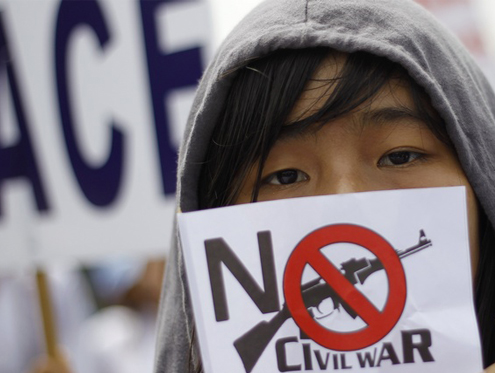For an event where only 7 percent of the 700 attendees were women, Burma’s first peace conference achieved a milestone on gender issues.
A day after the conference closed on 16 January, the front page of the state-owned newspaper The Global New Light of Myanmar ran an article titled “The four-point proposal approved by the first Union Peace Conference.”
The third point spelled out in detail what women’s rights groups have been calling for since the beginning of Burma’s nationwide ceasefire negotiations in 2011: “To enable at least 30 percent participation by women at different levels of political dialogues according to the political dialogue framework of nationwide ceasefire agreement (NCA)”.
The NCA text talks about the participation of a “reasonable number of women.”
It’s testament of the skill, grit and determination of a handful of female participants at the conference that despite being vastly outnumbered, they were able to make their presence felt. Less than two months ago, this seemed like wishful thinking.
On 18 December, I moderated a panel discussion with two steering committee members of the Alliance for Gender Inclusion in the Peace Process (AGIPP) and a female politician, all of whom lamented the lack of women’s participation in the discussions between the army and ethnic armed groups.
Burma’s internal conflict has displaced hundreds of thousands of people over the years, many of them women struggling to support their families, while sexual abuses against ethnic women in conflict areas were committed with impunity.
So the outcome of the peace conference is a big win for women’s rights activists. Yet, judging by the experience of the women who attended the five-day conference, it is too soon to celebrate.
Dismissive attitudes remain
On 22 January, five days after the conference ended, I once again moderated another discussion panel organised by the AGIPP. The four female speakers were well-known and respected; all recounted the challenges they faced in getting their voices heard.
Khin Ma Ma Myo, founder of the Rangoon-based Myanmar Institute for Peace and Security Studies, said despite speaking for a full 15 minutes in three discussions, none of what she said was reflected in the daily records and meeting minutes. When the situation persisted, she ended up taking the computers of the facilitators and typing in her talking points by herself just so that her remarks would be on record.
The other speakers said they encountered the same dismissive attitudes from some male counterparts and organisers. Thin Thin Aung from the Women’s League of Burma recounted having to call out a male facilitator for diluting points put across by female speakers. Others said some male participants addressed younger female attendees as “girl”.
It could take a while to adjust such attitudes, but what can be done immediately is to have policies and procedures in place so there’s a supportive environment that encourages more capable women to take part in the peace process.
Supportive policies needed
This includes understanding that women play multiple roles in Burmese society as caregivers, homemakers, mothers and leaders. Often, female leaders or activists would be invited to attend a meeting with a day’s or only a few hours’ grace, said Thandar Oo from a Shan civil society group.
“We can’t just put on a jacket and go. We have to arrange things for home and the family first. Then of course we were told: ‘Well we invited you but you didn’t come,’” she said.
Khin Ma Ma Myo said she was able to take part in conferences around the world more easily, traveling while her son was only a few months old thanks to the availability of childcare and support facilities. This was in sharp contrast to Burma’s Union Peace Conference where there was no such support, she said.
Naw May Oo Mutraw, who was a spokesperson for the Karen National Union (KNU) delegation during peace negotiations in 2012 and a research fellow with the Salween Institute for Public Policy, said she faced the same problem. She has a two-and-half-year-old son.
[related]
Naw May Oo Mutraw said women’s low social and economic status in Burma causes a lack recognition of their needs, and thus a lack of support that could help them participate and take leadership roles in the peace process. “The norms and traditions of our society enhance the ignorance of men about women’s needs,” she added.
The fixed 30 percent number is not the be all and end all, however. Just look at Indonesia, where the quota for female parliamentarians has only been used to address women’s rights in a superficial way. The positions for women lawmakers in Indonesia are given away and traded, serving only to strengthen money politics and political dynasties, and not necessarily to improve women’s rights.
If the 30 percent quota for women in Burma’s peace process is to have any meaning, there need to be gender-sensitive policies and procedures in place that support women and their needs while they participate in the peace process.
This could range from providing childcare support for mothers attending conferences and peace negotiations, to actively identifying and encouraging more women to participate, or for Burma to honour the international conventions and agreements to women’s rights, peace and security it signed.
Such steps could ensure their participation is meaningful, and that women and their words receive the same respect as their male counterparts. If not, the hard-won gains for women in Burma’s peace process are likely to achieve little.
This article was first published on 11 February 2016 by Myanmar Now.



